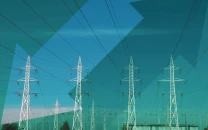Pakistan Development Fund: Billions in hand, none in the works
Despite having money, the PDF has not created any economic impact

Despite having money, the PDF has not created any economic impact. PHOTO: REUTERS
PDFL seems to be another case of foreign direct investment (FDI) flowing to boondoggles as foreign politics rather than a thoughtful business case in the driver’s seat. Claiming to screen commercial projects that are financially viable, PDFL was established to increase “economic impact” through co-financing of infrastructure development projects under innovative public private partnerships (PPP).
IFC likely to inject $500m into Pakistan Development Fund
One wonders that like PDFL, there is an existing entity called Infrastructure Project Development Facility (IPDF) - a public limited company owned by the Ministry of Finance that aims to leverage the untapped potential of the private sector in meeting infrastructure investment gaps. So why establish a new special-purpose vehicle instead of building capacity of IPDF with zero paid-up capital?
PDFL has been set up to participate in megaproject financing, money market and capital market activities. This makes it different from the IPDF that focused mainly on project preparatory work for PPPs such as preparing bid documents along with transaction structures for PPP modalities. IPDF was not even allowed to charge fees for its services from 2006 to 2013.
However, the question of the hour is: Why PDFL has not been able to turn around despite $1b contribution to the fund?
Problems with attaining success
Many international studies have confirmed that there is a strong correlation between board composition and valuation of state-owned companies in emerging markets eg Korean companies with 50% directors from private sector had 40% higher market valuation.
Unfortunately, all members of the PDFL’s Board of Directors are ex-officio members that speak volumes about why the idea has failed to jump-start. Secretary Finance is working as a honourary Chief Executive Officer since 2014 and there is little chance that a full-time CEO may be appointed in the near future. Diversity of the board should be ensured by bringing industry specialists from the private sector and CEO should be appointed on agreed “fit and proper” criteria to run the fund on commercial principles.
Also, when institutions are new and the obligor is a sub-sovereign entity, there are huge risks involved. Debt-based financing will also be difficult in such arrangements because of interest rate fluctuation risk. KIBOR-based lending works fine for power projects as change in interest rates are passed onto consumers but this is not straightforward in the case of infrastructure projects.
30 months on, Saudi $1.5b gift to Pakistan unspent
Asian Development Bank (ADB) agreed to participate in a pilot project of PDFL by lending to co-financers if the government issues sovereign guarantee in favour of ADB. International Finance Corporation (IFC) of the World Bank Group has shown expression of interest if it is offered majority stakes in the fund with powers to appoint a professional CEO. These terms were not acceptable to the Ministry of Finance as the government wishes to keep control of the company in their hands.
However, the development fund conundrum is not hard to crack. Once the government announces a national PPP policy and possible projects that shall be funded by PDFL, it can pitch it to domestic pension funds for investments in its long-term instruments. As pension funds have liabilities that stretch over decades and infrastructure projects have positive cash flows after an average of seven years, these two can have a strategic fit that can transform to a possible success story. So PDFL could be a good alternative to treasury bills and bonds for pension funds.
Such initiatives cannot take off unless government realises that they serve as custodians to these strategic assets and are accountable to the nation for delay in execution of action plans.
The writer is a Cambridge graduate and is working as a management consultant.
Published in The Express Tribune, February 13th, 2017.
Like Business on Facebook, follow @TribuneBiz on Twitter to stay informed and join in the conversation.



















COMMENTS
Comments are moderated and generally will be posted if they are on-topic and not abusive.
For more information, please see our Comments FAQ